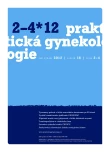Incidence of uterine cervix HPV infection after conization
Authors:
Sylvia Kurimská; Ľubica Hammerová; Andrea Maľová; Martin Redecha
Authors‘ workplace:
I. gynekologicko-pôrodnícka klinika LF UK a UN, Bratislava, Slovensko
Published in:
Prakt Gyn 2012; 16(2-4): 66-68
Category:
Oncogynecology: Original Article
Overview
Purpose:
The aim of the study was to find out the persistance of infection (reinfection) by high risk human papillomaviruses in patients after uterine cervix conization for CIN 2 and 3.
Material and methods:
We have observed patients after conization for CIN 2 and 3 from October 2010 until May 2012. Women were examined by colposcopy, oncocytology and HPV testing (Hybrid Capture II®).
Results:
The prebioptic diagnostic methods, 6 and 12 months after the primary operation, did not show any signs of the recurrent cervical lesions. 6 months after the conization there was high risk HPV positivity in 11 women (39,3 %), 5 cases CIN 2 and 6 with CIN 3. 12 months after the conization there was high risk HPV positivity in 8 women (28,6 %), out of which 3 patients had CIN 2 and 5 had CIN 3.
Conclusions:
The results of our study show high probability of HPV persistence (reinfection) after the treatment of major uterine cervix precancerosis.
Key words:
HPV – uterine cervix precancerosis – conization
Sources
1. Nagai Y, Maehama T, Asato T et al. Persistence of Human Papillomavirus Infection after Therapeutic Conization for CIN 3: Is It an Alarm for Disease Recurrence? Gynecol Oncol 2000; 79(2): 294–299.
2. Nam K, Chung S, Kim J et al. Factors associated with HPV persitence after conization in patients with negative margins. J Gynecol Oncol 2008; 20(2): 91–95.
3. Song SH, Lee JK, Oh MJ et al. Persistent HPV infection after conization in patients with negative margins. Gynecol Oncol 2006; 101(3): 418–422.
4. Kim YT, Lee SY, Cho CH et al. Clearance of human papillomavirus after succesful conization in patients with cervical intraepithelial neoplasia. Int J Cancer 2010; 126(8): 1903–1909.
5. Strander B, Andersson-Ellstrom A, Milsom D et al. Long term risk of invasive cancer after treatment for cervical intraepithelial neoplasia grade 3: population based cohort study. Br Med J 2007; 335(7629): 1077.
6. Costa S, De Simone P, Venturoli S et al. Factors predicting human papillomavirus clearance in cervical intraepithelial neoplasia lesions treated by conization. Gynecol Oncol 2003; 90(2): 358–365.
7. Sarian LO, Derchain SF, Pitta Dda R et al. Factors associated with HPV persistence after treatment for high-grade cervical intra-epithelial neoplasia with large loop excision of the transformation zone (LLETZ). J Clin Virol 2004; 31(4): 270–274.
8. Lu CH, Liu FS, Kuo CJ et al. Prediction of persistence or recurrence after conization for cervical intraepitelial neoplasia III. Obstet Gynecol 2006; 107(4): 830–835.
9. Dalstein V, Riethmuller D, Pretet JL et al. Persistence and load of high-risk HPV are predictors for development of high-grade cervical lesions: a longitudinal French cohort study. Int J Cancer 2003; 106(3): 396–403.
10. Franco EL, Villa LL, Sobrinho JP et al. Epidemiology of acquisition and clearance of cervical human papillomavirus infection in women from a high-risk area for cervical cancer. J Infect Dis 1999; 180(5): 1415–1423.
11. Park JY, Lee KH, Dong SM, et al. The association of pre-conization high-risk HPV load and the persistence of HPV infection and persistence/recurrence of cervical intraepithelial neoplasia after conization. Gynecol Oncol 2008; 108(3): 549–554.
12. Kreimer AR, Guido RS, Solomon D et al. Human papillomavirus testing following loop electrosurgical excision procedure identifies women at risk for posttreatment cervical intraepithelial neoplasia grade 2 or 3 disease. Cancer Epidemiol Biomarkers Prev 2006; 15(5): 908–914.
13. Alonso I, Torné A, Puig-Tintorne LM et al. Pre- and postconization high-risk HPV testing predicts residual/recurrent disease in patients treated for CIN 2–3. Gynecol Oncol 2006; 103(2): 631–636.
14. Sláma J. Follow-up after conservative surgery for cervical precancer lesions. Ceska Gynekol 2011; 76(5): 339–342.
15. Dillner J, Kjaer SK, Wheeler CM et al. Four year efficacy of prophylactic human papillomavirus quadrivalent vaccine against low grade cervical, vulvar, and vaginal intraepithelial neoplasia and anogenital warts: randomised controlled trial. FUTURE I/II Study Group. Br Med J 2010: 341.
Labels
Paediatric gynaecology Gynaecology and obstetrics Reproduction medicineArticle was published in
Practical Gynecology

2012 Issue 2-4
Most read in this issue
- Diagnosis and therapy of some extragenital forms of endometriosis
- How to behave when giving medical treatment to foreigners: pitfalls, findings and recommendations
- Ulipristal acetate: new antiretroviral drug in treatment of uterine fibroids
- Anorgasmia and frigidity
